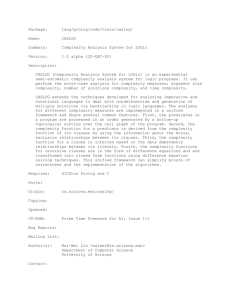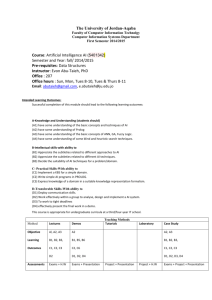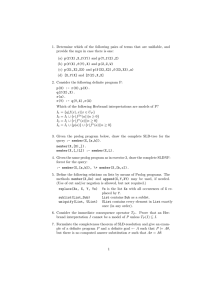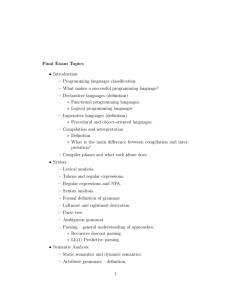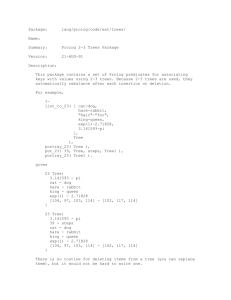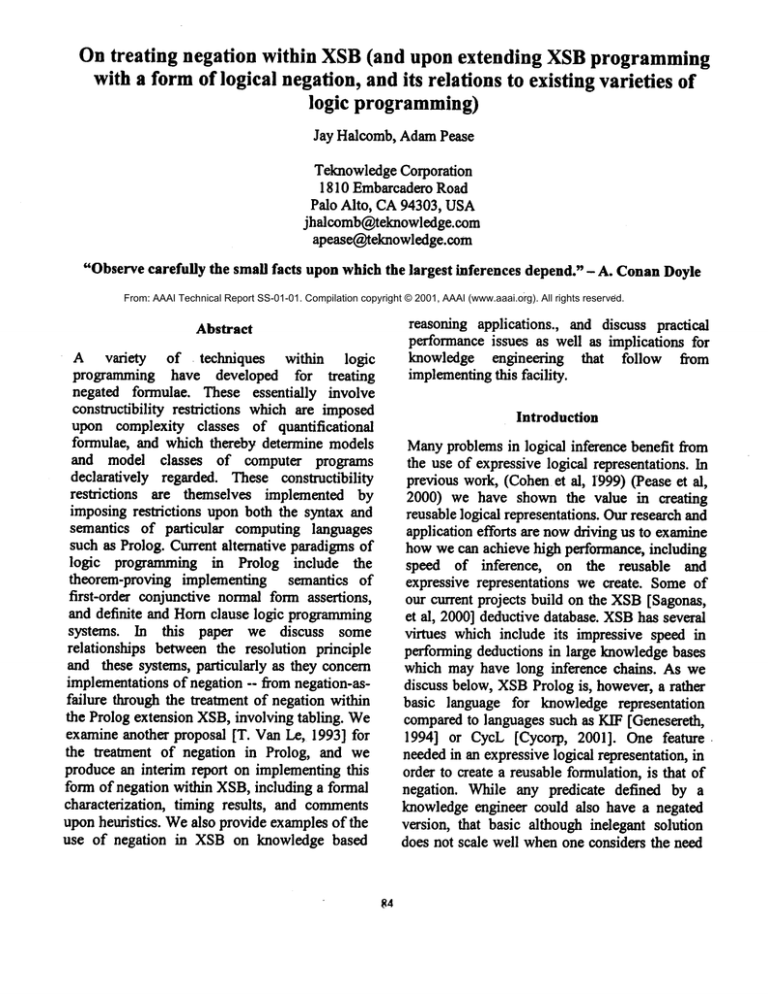
On treating negation within XSB(and upon extending XSBprogramming
with a formof logical negation, andits relations to existing varieties of
logic programming)
Jay
Haleomb, AdamPease
Teknowledge Corporation
1810 Embarcadero Road
Palo Alto, CA94303, USA
jhalcomb@teknowledge.com
apease@teknowledge.com
"Observecarefully the small facts uponwhich the largest inferences depend."- A. ConanDoyle
From: AAAI Technical Report SS-01-01. Compilation copyright © 2001, AAAI (www.aaai.org). All rights reserved.
Abstract
A variety
of techniques
within logic
programming have developed for treating
negated formulae. These essentially involve
constructibility restrictions which are imposed
upon complexity classes of quantifieational
formulae, and which thereby determine models
and model classes of computer programs
declaratively regarded. These construetibility
restrictions
are themselves implemented by
imposing restrictions upon both the syntax and
semantics of particular computing languages
such as Prolog. Current alternative paradigms of
logic programming in Prolog include the
theorem-proving implementing semantics of
first-order conjunctive normal form assertions,
and definite and Horn clause logic programming
systems. In this paper we discuss some
relationships between the resolution principle
and these systems, particularly as they concern
implementations of negation -- from negation-asfailure through the treatment of negation within
the Prolog extension XSB,involving tabling. We
examine another proposal [T. Van Le, 1993] for
the treatment of negation in Prolog, and we
produce an interim report on implementing this
form of negation within XSB,including a formal
characterization, timing results, and comments
upon heuristics. Wealso provide examplesof the
use of negation in XSB on knowledge based
84
reasoning applications., and discuss practical
performance issues as well as implications for
knowledge engineering
that follow from
implementingthis facility.
Introduction
Manyproblems in logical inference benefit from
the use of expressive logical representations. In
previous work, (Cohenet al, I999) (Pease et
2000) we have shown the value in creating
reusable logical representations. Ourresearch and
application efforts are nowdriving us to examine
howwe can achieve high performance, including
speed of inference,
on the reusable and
expressive representations we create. Someof
our current projects build on the XSB[Sagonas,
et al, 2000] deductive database. XSBhas several
virtues which include its impressive speed in
performing deductions in large knowledgebases
which may have long inference chains. As we
discuss below, XSBProlog is, however, a rather
basic language for knowledge representation
comparedto languages such as KIF [Genesereth,
1994] or CycL [Cycorp, 2001]. One feature
neededin an expressive logical representation, in
order to create a reusable formulation, is that of
negation. While any predicate defined by a
knowledge engineer could also have a negated
version, that basic although inelegant solution
does not scale well whenone considers the need
to negate compoundformulae. For this reason,
we believe that logical negation is a key feature
for a reasoning system that is to handle a
knowledge base of any significant size. The
issues to be considered in fully implementing
logical negation in a knowledgerepresentation
system include: inferential
soundness and
completeness,and efficiency.
Backgroundto the negation problemin logic
programming:Unification and the Resolution
Principle
J.A. Robinson [1965] introduced the resolution
principle for logic programming. Various
refinements and extensions of the general method
have been formulated since..Some version of the
resolution principle is used in most modemlogic
programming languages, and in Prolog (and
XSB)in particular. Theresolution principle is an
inference rule which maps a pair of sentences
within a first-order languageto another sentence,
according to a schema which we will shortly
produce: But to discuss the resolution principle,
first we must mention the operations
of
substitution and unification.
Terms in our language are either: variables,
individual constants, or the result of applying
atomic function constants to variables or
individual constants (as in, e.g., f(X,a,h(gCO)).
Unification is an operation upon two atomic
formulae (say, A and B) which, whensuccessful,
produces a substitution of (possibly new) terms
for those occurring in A and B such that the
result of the substitution
makes A and B
identieai. Such a substitution is called a unifier
for A and B.
An important fact about the unifiers for two
expressions A and B is that when they exist,
there is a ’least’ such unifier - one whichmakes
the fewest substitutions possible which render A
and B identical. Such a unifier is called a ’most
general unifier’.
To explain the resolution principle, first we write
Sub(X,E) to indicate the result of uniformly
makingsubstitutions of the vector of terms, X,
for selected terms occurring in E. A convenient
wayof indicating such substitutions is with, e.g.,
the notation: [X/a, f(X)/b]..
FromA1 v...v An and BI v...v Bm, infer
Sub(X, (A1 v...v Aj-1 v Aj+I v...v B1 v...v Bk-1
v Bk+l v...v Bm), where X is that substitution of
terms for terms which is the most general unifier
for the expressions Aj and Bk; i.e., X is the least
substitution of terms such that Sub(X,Aj)
Sub(X,not Bk).
The resolution principle itself relies upon the
nontrivial notions of substitution of terms, and
the unification of terms (and, by extension)
formulae. In consideration of space, though, we
must omit discussion of these details.
The
important fact for us nowis that resolution is a
powerful generalization of the inference rule
traditionally
known to logicians as Modus
Ponens. Using resolution,
operating under
appropriate selection/generation strategies for the
materials to resolve uponin constructing a proof,
it is possible to derive refutation-completeproof
procedures for significant classes of expressions
of FOLRefutation-completeness means that if a
set of sentences of FOLis unsatisfiable (has no
model), then the resolution process will derive, in
finitely manysteps, a contradiction fi’om that set.
Since a standard strategy for proving that a set of
sentences, S, logically implies another sentence
A is to conjoin the negation of A with the
conjunction of those in S and then to infer a
contradiction from that expression, the resolution
principle can (after appropriate Skolemization
and canonicalization) be used to showthe logical
implication of A from S, for various forms of
sentences. [See, for instance, Chang and Lee,
1973]
Normal Forms
The second important fact we notice is that
amongthe classes of formula types of FOL, for
(Resolution principle, one form)
85
logic
programming
purposes,
thefollowing
areof
inference which results from evaluating only
particular
note
(inincreasing
order
ofrestriction):
definite clauses, i.e., expressionsof the form:
the conjunctive normal form, the Horn form,
and the definite clause form. Webriefly discuss
not PI v ... v not Pnv Pn+l
each of these.
whereeachPi isan atomic
literal
formula.
Such
The conjunctive normal form of a sentence of
formulae
arethemselves
logically
equivalent
to
FOLis any conjunction of expressions, each
expressions
of theform
conjunct of which is of the form (for somen and
some m, possibly one or the other 0):
P1 &... &Pn-1 ffi> Pn (and are written in Prolog
as Pn:-Pl,...,Pn-1.)
not AI v ... v not Anv An+lv ... v Am
Wenotice that the restriction to definite clauses
The important fact here is that we may
is imposed by the requirement that there be at
legitimately speak of the conjunctive normal
least one positive (un-negated) literal in the
form of any expression of FOL, since any
disjunctions
of the conjunctive
normalform.
expression of FOLhas a provably equivalent (in
SinceProlog
simpliciter
alsodoesn’t
allowfor
a certain sense) conjunctive normalform.
the evaluationof expressions
of the form
A Horn clause is any conjunction
of
PI &... & Pn ffi> false (in Prolog this wouldbe
expressions each of the form:
an illegal expression: fail:- P1, ... , Pit.)
not AI v ... v not Anv Am
this imposes a further reduction upon the
whereeither m or n maybe O.
canonical forms to which Prolog inference can be
directly applied. Suchclauses must be def’mite -A definite clause is a further restriction of the
must
have at least one positive atomic disjunct.
Horn form. It is any conjunction of expressions
This restriction
means that direct Prolog
each of the form:
resolution cannot directly represent nor resolve
disjunctive facts of the form not P1 v...v not Pn.
not A1v ... v not An v An+l
where n maybe O.
Even when Prolog is augmented with the
addition of its usual ’not’ operator, which
expresses negation-as-failure, it is inferentially
complete only expressions which have Horn
clause canonical form.
By imposing restrictions or other refinements
upon the general resolution principle, and by
devising appropriate control (e.g., selection)
strategies,
the logic programmer can devise
refutation-complete proof methods for each of
the classes of normal forms we’ve mentioned.
For ground formula, the ’negation-as-failure’
method of evaluation amounts to the ’dosedworld’ assumption, that a ground formula p(a)
Logic programs and theorem proving
false whenevereither the assertion p(a) does not
appear in the program,or it is not deduciblefrom
Prologis oneinstance
of a logicprogramming assertions in the programcontext.
language embodyingKowalski’sprecept
’algorithm=logic-l-control’.
But’vanilla’
Prolog This anomaly arises from the typical Prolog
implementation
of ’not’, which behaves
(Prologwithoutany ’not’operatorat all)
functionally as though:
requires
thatthe ’logic’
of thisequation
be
definite
-clause
logic:
therestriction
to FOL
86
notOO:-caH(X),!,fail.
not(X):-true.
But in particular the evaluation of a negated body
subgoal, not bOO,
as in (*) all(X) all(Y)(aCX):-not boo)
all(X) (a(X) :- exists(Y)( not Howeve
r,
standard Prolog evaluates rules of the form
(*) as: an(X) (a(X):- not exists(OO bOO).
A typical
sentence of FOL which has no
equivalent Hornclause normal form (hence, still
less any definite clause form) is the axiom
expressing atomicity within Boolean algebras:
exists(X) all(Y)(not (X=O)&(x*y=y =>
=0))
Without the means to resolve upon such
expressions, the full inferential capability of FOL
cannot be directly employed upon knowledge
representations. On the other hand, it is well
known that the introduction of such means
introduces considerable complexity, and a
concomitant inefficiency, into the evaluation of
knowledge representations.
An inference
capability which operates to prove theorems in
FOLwhich can be expressed in conjunctive
normal form (and hence any theorem of FOL),
called a theorem prover. Theorem provers
improve upon other forms of logic programming,
like Prolog, by being able to resolve the full
generality of expressions in conjunctive normal
form, not merely those in Hornclause or definite
clause form.
A closer look at the problemof negation in
Prolog
Prolog with the addition of the usual ’not’
operator treats the evaluation of positive and
negated goals differently. Whilea positive goal,
fCX), is evaluated by searching for a proof of
existsCX) (fO0), negated goal, no t(fCX)), is
evaluated for a proof of all(X)(not fiX)), as
be shown.
Logically,
a sentence
of the form,
all(X) all(Y) (b(X)=>aO0) is equivalent
all(X) exists(Y)(b(Y) ffi> a(X)) so that
evaluation of a goal a(X):-b(Y) ought to
evaluated as: allOO(aOO:- exists(Y) bOO).
so it is, for non-negatedpredicates.
Such inference is sound, when it succeeds for
groundX, but it is not logically completein the
general
case, for unbound X. This is
demonstrated by Prolog’s not returning a binding
for Xin such cases.
Prolog may also sometimes involve itself in
infinitely looping processes during the resolution
of certain forms of expression (those involving
circular reference). This is because it employs
’depth-first’ search strategy, whichmaylead to it
continue pursuing an unfruitful inference path.
XSBprovides a mechanism, tabling, which can
control this behavior in manyeases. [Warren,
2000].
VanLe negation: the ’non’ operator
Van Le (Techniques of Prolog Programming,
[1993]) offers another approach to the negation
problem. In constructing an expert system shell,
he defines a Prolog predicate ’non’ such that the
evaluation of (the attempt to unify) a goal
non(fiX)) seeks a maximallygeneral substitution
for fiX) such that fiX)fails. 1.e., it fails if there
are no values of X such that fiX) holds, but
moreover if there is a value for X such that
nonOC(X))holds , that value is returned..
algorithm which implements this evaluation is
not overly complex and Van Le is able to
demonstrate for this methodof treating negation
that non(non(p(X))implies
It is a feature of this methodthat such evaluation
requires that Prolog has beforehand distinguished
the function and constant symbols in use. It is
because of this distinguished treatment that ’non’
87
is able to return values. That it does return such
values yields mother feature of the ’non’
predicate: it can be used to define the universal
quantifier ’all’, (roughly expressed - we omit
details about renaming of variables to avoid
clashes) throughthe definition:
capableOfDoing(unitedNationsOrganization,
CONFLICT,
mediators) :instance_of(CONFLICT,intemafionalConfliet),
instance_o f(COUNTRYA,
country),
instance_o f(COUNTRYB,
country),
opponentslnConflict(COUNTRYA,
COUNTRYB,CONFLICT).
all(X, p(X)):- not(non(p(X)).
The last clause maybe read: it is false that
exists(X, non(p(X)).
instanee_of(OBJ, SUPERSET)
OBJ~=SUPERSET,
instance of(OBJ, SUBSET),
subset_of(SUBSET, SUPERSET).
Similarly, all(X, not p(X)) may be defined
not(p(X)). With suitable definitional extensions,
it is then possible to define multiple
quantification, as in all(X, exists(Y, p(X,Y)).
Input query: setof(WHO, all(CONFLICT,
implies( and( instance_of(CONFLICT,
territorialDispute), opponentslnConfliet(iran,
iraq, CONFLICT)),capableOtDoing(WHO,
CONFLICT,
mediators))), LIST).
Examples in XSB
Answer: [unitedNationsOrganization].
Employing an adaptation
of Van Le’s
methodology, the following (and similar) data
and query have been run at Teknowledgein XSB.
The input materials were derived from the High
Performance KnowledgeBase project (Pease, et
al, 2000).
Althoughthis query was run interpreted (and run
over a miniscule KB), the evaluation of this
query in XSBwas so rapid (on a moderately
quick PC), that the attempt to time it fell beneath
the horizon of XSB’s cpu timing mechanism,
which measures epu speed in 10,000ths of a
second. However, compilation always produces
increases in efficiency over interpretation.
Facts in the K_B:
instance_of(hYP_TerritorialDispute_.28532600,
territorialDispute).
Theoremprovers, again
One theorem
prover
which has been
implementedas an Prolog compiler is PTTP:the
Prolog Technology Theorem Prover [Stiekel,
1988, 1989]. PTTPis a refutation-complete
inference engine for FOLwhich uses a slight
extension of the Resolution Principle we have
mentioned. One of the techniques which PTTP
uses to achieveits level of generality is to employ
negation, not as an operator, but in the form of
individually negated predicates, i.e., for each
predicate p(x), the negation of the predicate
expressed as a predicate,
not_p(X). This
translation
is accomplished during the
compilationstate of a query (and so adds little to
the execution process, while it is transparent to
subset of(territorialDispute,
intemationalConflict), isa(iraq, country).
instanceOf(iran, country).
opponentslnConflict(iran, iraq,
hYP_TerritorialDispute_28532600)
Rules in the KB:
opponentslnConfliet(Y, X, EVENT)
opponentslnConflict(X, Y, EVENT).
88
the user), but it has the drawbackthat PTTPmust
compile each contained disjunction
of an
expression in conjunctive normal form in both
positive and in several contrapositive forms. This
last feature does impedeexecution. It also means
that PTTP must sometimes be resolving over
highly ’unnatural’ forms; hence, forms less likely
to produce fi’uitful inferences in the course of
proof construction.
Sagonas, Swift, Warren, Freire, Rao, Dawson,
Kife. April 4, 2000. The XSBSystem, Version
2.2, Vols. 1, 2, Programmer’s Manual,
http://xsb.sourceforge.net/.
Stickel, M.E. 1988. A Prolog technology theorem
prover: implementation by an extended Prolog
compiler. Journal of AutomatedReasoning 4, 4,
353-380.
Stickel, M.E. June, 1989. A Prolog technology
theorem prover:
a new exposition and
implementation in Prolog. Technical Note 464,
Artificial Intelligence Center, SILl International,
MenloPark, California.
At Teknowledge we are presently implementing
an XSB compiler
for our knowledge
representations which employs an adaptation of
the VanLe strategy of negation.
References
Cohen, Chaudhri, Pease and Schrag. 1999. Does
Prior KnowledgeFacilitate the Developmentof
Knowledge Based Systems, proceedings of
AAAI-99.
Cycorp, 1999, Features of the CycLLanguage.
http://www.cyc.com/cycl.html
Chang , C-L and Lee, R C-T. 1973. Symbolic
Logic and Mechanical Theorem Proving.,
Academic Press, NewYork.
Genesereth, M. and Fikes, R. 1995, Knowledge
Interchange
Format
v.
3.0.
http://logic.stanford.edu/kif/Hypertext/kifmanual.html
Hogger, Christopher. 1984. Introduction to Logic
Programming. Academic Press, London.
Pease, A., Chaudhri, V., Lehmann, F., and
Farquhar, A., 2000, Practical
Knowledge
Representation
and the DARPA High
Performance
Knowledge Bases Project,
proceedings of KR-2000.
Robinson, J.A. January, 1965. A Machine
Oriented Logic Based on the Resolution
Principle. J. ACM
12, pp. 23-41.
89
Van Le, T. 1993. Techniques of Prolog
Programming (with implementation of logical
negation and quantified goals). John Wiley
Sons, Inc., NewYork, 601 pp.
Wan-en, David S. July 31, 1999. Programmingin
Tabled
Prolog
(Dratt).
http://www.cs.sunysb.edu/~warren/xsbbook/book
.html



